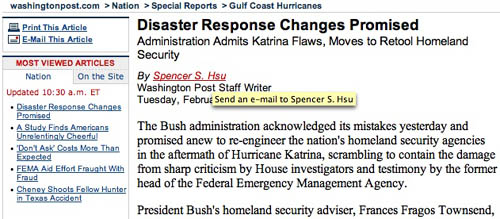In an effort to more directly engage readers, two of America’s most august daily newspapers are adding a subtle but potentially significant feature to their websites: author bylines directly linked to email forms. The Post’s links are already active, but as of this writing the Times, which is supposedly kicking off the experiment today, only links to other articles by the same reporter. They may end up implementing this in a different way.

screen grab from today’s Post
The email trial comes on the heels of two notoriously failed experiments by elite papers to pull readers into conversation: the LA Times’ precipitous closure, after an initial 24-hour flood of obscenities and vandalism, of its “wikatorials” page, which invited readers to rewrite editorials alongside the official versions; and more recently, the Washington Post’s shutting down of comments on its “post.blog” after experiencing a barrage of reader hate mail. The common thread? An aversion to floods, barrages, or any high-volume influx of unpredictable reader response. The email features, which presumably are moderated, seem to be the realistic compromise, favoring the trickle over the deluge.
In a way, though, hyperlinking bylines is a more profound development than the higher profile experiments that came before, which were more transparently about jumping aboard the wiki/blog bandwagon without bothering to think through the implications, or taking the time — as successful blogs and wikis must always do — to gradually build up an invested community of readers who will share the burden of moderating the discussion and keeping things reasonably clean. They wanted instant blog, instant wiki. But online social spaces are bottom-up enterprises: invite people into your home without any preexisting social bonds and shared values — and add to that the easy target of being a mass media goliath — and your home will inevitably get trashed as soon as word gets out.
Being able to email reporters, however, gets more at the root of the widely perceived credibility problem of newspapers, which have long strived to keep the human element safely insulated behind an objective tone of voice. It’s certainly not the first time reporters’ or columnists’ email addresses have been made available, but usually they get tucked away toward the bottom. Having the name highlighted directly beneath the headline — making the reporter an interactive feature of the article — is more genuinely innovative than any tacked-on blog because it places an expectation on the writers as well as the readers. Some reporters will likely treat it as an annoying new constraint, relying on polite auto-reply messages to maintain a buffer between themselves and the public. Others may choose to engage, and that could be interesting.
if:book
A Project of the Institute for the Future of the Book

what i’d really like to see is a format which allowed comments to be posted directly to articles.
Me too. The Post does include a little Technorati-powered “who’s blogging?” window beside each article, but that’s as close as you get to direct reader comments. I don’t see why they don’t try out a moderated comment option with some basic ground rules. It would be essentially the same as letters to the editor only integrated with the article.